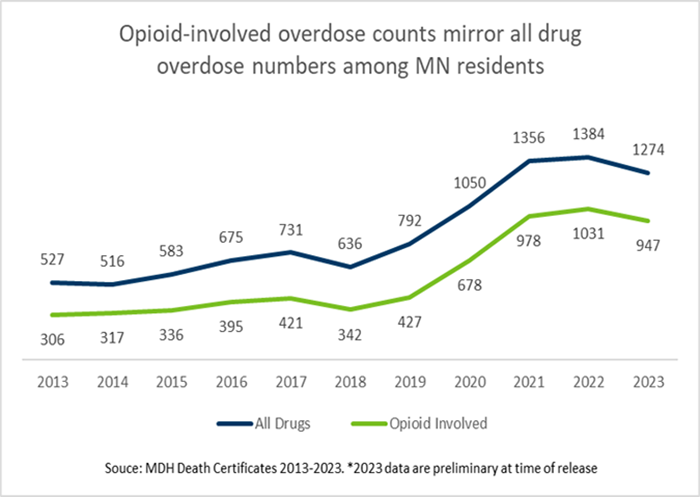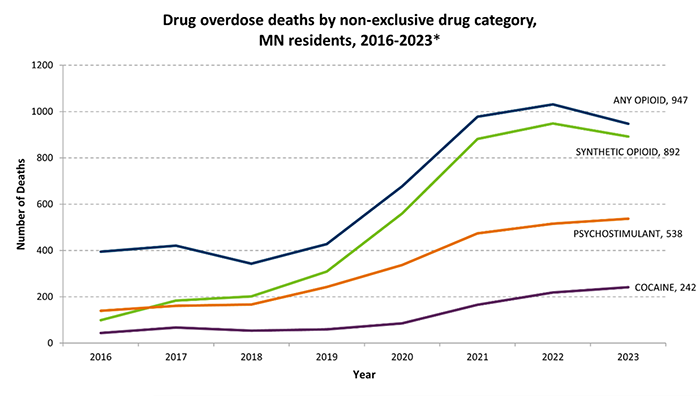Preliminary data show a decrease in overdose deaths in 2023From 2022 to 2023, Minnesota saw an 8% decrease in overall drug overdose deaths from 1,384 to 1,274 deaths among residents in the state, according to preliminary data. Though the numbers are still preliminary, 2023 likely marks the first time since 2018 that Minnesota has seen a drop in total overdose deaths among its residents. Greater Minnesota experienced a 21% decrease in overdose deaths (482 to 381 deaths). The seven-county metro area saw a 1% decrease as well (902 to 893 deaths). Nonfatal overdoses involving opioids other than heroin (like fentanyl) increased by 11% (4,328 to 4,819 overdoses). "We have seen a decline in opioid deaths, alongside an increase in nonfatal overdoses, in part due to greater naloxone availability," said Minnesota Commissioner of Health Dr. Brooke Cunningham. "We know the work is not done, and we cannot rest. Every overdose is one too many, and we are committed to continuing to work with partners across the state to identify additional strategies that will save more lives." "This is encouraging news but there is much more to do," said Addiction and Recovery Director Jeremy Drucker. "The state and its partners remain laser-focused on continuing the work to ensure every Minnesotan is healthy and safe." Total overdose deaths essentially plateaued with a slight increase between 2021 and 2022, though early preliminary numbers had indicated a potential drop. These numbers are preliminary and are likely to increase when final, because they do not include Minnesota residents who might have died from an overdose while in another state. Most fatal overdoses (about 70%) involved synthetic opioids like fentanyl. However, the number of opioid-involved deaths in Minnesota was also down 8% from 2022 to 2023 (1,031 to 947 deaths), according to preliminary data.
Minnesota overdose deaths in the synthetic opioid category that includes fentanyl are down 6%, (949 to 892 deaths). Most cases in this category are assumed to involve illicitly manufactured fentanyl. All other opioid related categories including prescription opioids, heroin and methadone continued to see a decrease in deaths. Minnesota's preliminary 2023 overdose data is reflective of national trends. The CDC reports a nationwide 3% decrease in all overdose deaths from 2022 to 2023. While opioid-involved deaths went down in 2023, deaths from the psychostimulant category, which includes methamphetamine, continued a 10-year upward trend with meth deaths increasing 4% (516 to 538 deaths) and cocaine 11% (219 to 242 deaths).
Furthermore, for every one overdose death in 2023, there were nearly 13 nonfatal overdoses treated in Minnesota hospitals, with the number of visits remaining elevated but stable from 2022. As drug overdose remains a crisis in Minnesota that impacts communities to varying degrees, MDH, Tribal nations, local public health and health organizations have increased their investments in overdose prevention activities. Minnesota continues to be on the forefront of overdose prevention. Governor Tim Walz and Lieutenant Governor Peggy Flanagan's 2023 One Minnesota Budget included more than $200 million to address substance use and overdoses -with $50 million of that coming to MDH over the next four years. The investment addresses prevention, harm reduction, treatment and recovery. Additionally, the governor and Legislature passed a policy to reduce drug overdose deaths by requiring all schools, law enforcement officials, emergency responders and residential treatment programs to have naloxone on hand. MDH and the Minnesota Department of Education have posted a toolkit to help schools obtain cost-free naloxone and implement the new requirement. Additional state-led activities include expanding medication for opioid use disorder (MOUD); establishing new peer recovery support systems; and launching the MN Naloxone Portal where mandated groups, Tribes, Syringe Service Programs and organizations serving unsheltered Minnesotans can access no-cost naloxone. From September 2023 through July 2024, more than 124,000 nasal naloxone kits were distributed through this portal. Collaboration with other state agencies and federal funding partners help make this overdose and substance use response work possible. Read the full 2023 preliminary report: Statewide Trends in Drug Overdose: Preliminary 2023 Data Update (PDF). -MDH- Media inquiries: |
Wednesday, October 9, 2024
News Release: Preliminary data show a decrease in overdose deaths in 2023
Subscribe to:
Post Comments (Atom)
Page List
Blog Archive
- October 2024 (838)
- September 2024 (2667)
- August 2024 (3156)
- July 2024 (3241)
- June 2024 (3107)
- May 2024 (3196)
- April 2024 (3104)
- March 2024 (3192)
- February 2024 (3006)
- January 2024 (3261)
- December 2023 (3176)
- November 2023 (3188)
- October 2023 (3191)
- September 2023 (2961)
- August 2023 (3120)
- July 2023 (3024)
- June 2023 (3042)
- May 2023 (3205)
- April 2023 (3030)
- March 2023 (2986)
- February 2023 (2584)
- January 2023 (2694)
- December 2022 (2745)
- November 2022 (2899)
- October 2022 (2916)
- September 2022 (2970)
- August 2022 (2981)
- July 2022 (2814)
- June 2022 (2759)
- May 2022 (2768)
- April 2022 (2692)
- March 2022 (2851)
- February 2022 (2550)
- January 2022 (2715)
- December 2021 (2641)
- November 2021 (2745)
- October 2021 (2836)
- September 2021 (2847)
- August 2021 (2756)
- July 2021 (2572)
- June 2021 (2738)
- May 2021 (2579)
- April 2021 (2698)
- March 2021 (2789)
- February 2021 (2532)
- January 2021 (2617)
- December 2020 (2664)
- November 2020 (2637)
- October 2020 (2824)
- September 2020 (2745)
- August 2020 (2704)
- July 2020 (2749)
- June 2020 (2669)
- May 2020 (2199)
- April 2020 (4060)
- March 2020 (5898)
- February 2020 (6963)
- January 2020 (7455)
- December 2019 (10)
Search This Blog
News Release: Preliminary data show a decrease in overdose deaths in 2023
Preliminary data show a decrease in overdose deaths in 2023 From 2022 to 2023,...

-
View Images Library Photos and Pictures. Как сделать усилитель сигнала сотовой связи своими руками Усилитель 3G сигнала своими руками Антен...
-
Download Images Library Photos and Pictures. 3 Graduation Invitation Letter Sample Invitation Letter Sample Invitation Letter To Friend For...




No comments:
Post a Comment